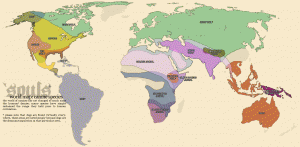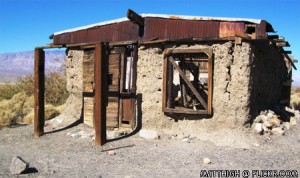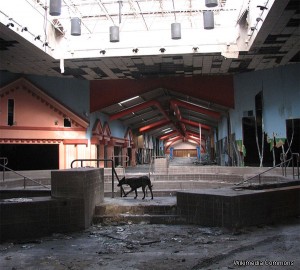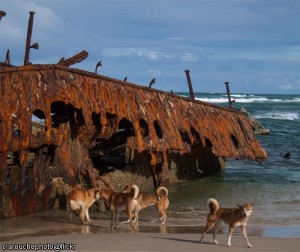‘Souls takes place in the Maritime Provinces of eastern Canada. However, while our playable territories are restricted to this area, our universe extends beyond these artificial borders to encompass the entire world. Players are free to create and play characters originating from other countries and continents and to contribute to the greater ‘Soulsverse via the Wiki. The general characteristics of Luperci populations around the world should be kept in mind though!
North America
Following humanity’s demise, wolves and coyotes quickly expanded their territories to take back areas they’d been forced out of, and packs of these species stuck to their traditionally feral ways for a long time. Nonetheless, more humanized lifestyles did crop up in certain areas, and after the turn of the millennium, Luperci from overseas areas began landing on the east coast, bringing with them some technologies that first arose overseas.
Wary of their wild relatives, dogs of survivable breeds banded together, mostly sticking to areas formerly occupied by humanity. Having been close to their fallen human companions, Luperci dogs were quicker to pick up human abilities like reading and writing. However, competition and mistrust amongst breeds led to widespread violence and lack of order, preventing them from properly utilizing knowledge and skills that may have advanced them more quickly. Eventually though, interbreeding and distance from their initial conflicts brought dogs better stability.
Specific Populations

Wolves, coyotes, and dogs can be found in abundance everywhere in North America. Nonetheless, certain areas maintain dominance of a specific species:
- Wolves reclaimed much of their former territories and ranges — especially territories with large swathes of untouched wilderness. Much of midwestern and central Canada and the United States are dominated by wolf populations. This is especially true in the extreme northern parts of Canada, where coyotes and non-hardy dogs cannot survive.
- Coyotes, whose populations had flourished and grown larger in the time of humanity, experienced some loss of territory following the wolves’ population surge. Central America, as well as some parts of the southern United States, are still coyote-dominant — but their populations across North America have otherwise been reduced.
- Many dog packs moved south to occupy Mexico and the lower eastern parts of the United States. Alaska also serves as a pocket of spitz-type dogs and wolfdog packs.
Lifestyles
Organized religions and some rudimentary forms of trade economies have formed in North America, but the lifestyle and culture tends to be less rigid, organized, strict, or “official” than the more advanced parts of the world. Simplistic and traditional pack lifestyles are still far more abundant in North America, especially further away from the coasts and former human cities.
 Advanced Parts of the Luperci World
Advanced Parts of the Luperci World
Some of the most advanced lifestyles of all Luperci occur in Europe, western Asia, and northern Africa. Because of Europe’s greater human population density and relatively few natural disasters, more human structures, artifacts, and resources survived here than anywhere else, providing Luperci populations with a wealth of knowledge. Smaller pre-apocalypse wild canine populations here and a more docile dog population also allowed species to mix with less conflict than in other places, so Luperci were more able to focus on picking up and learning things that the humans had left behind.
Advanced versus Primitive
Technology
Even the most advanced parts of the Luperci world are not home to working engines, running water, or electricity. Advanced technology to Luperci include primitive forms of the following: weaponry and medicine, metalworking and construction, livestock keeping and crop growing, and other basic, primitive technologies. “Industrialized cities” of thousands of Luperci are not found anywhere in the ‘Soulsverse — our Luperci simply have not progressed to this degree as of yet.
See ‘Soulsverse > Realism for more information regarding realistic technology.
Lifestyles
What is definitely more advanced in these parts of the world are lifestyles and cultures. More strict, larger forms of hierarchy can be found — e.g., kings, trade pacts, alphas who answer to an alpha’s alpha, etc. That said — traditional lifestyles resembling natural canine packs are absolutely found in these advanced areas of the world, too.
Europe

Europe is home to many of the most Luperci-populous “cities”; however, the higher population density and fewer areas of open wilderness can make survival in such places difficult. Many cities are located along trade routes — either via land or sea — and are supplied with food (preserved, dried, pickled, smoked, salted; as well as livestock and live prey) from more remote, rural areas in the Luperci world.
Perhaps the most advanced city in the Luperci world is Warsaw, Poland — a Luperci-constructed “city.” The most populous area in the Luperci world is London, England — home to just over five hundred Luperci. Cities of thousands of Luperci do not exist within the ‘Soulsverse.
Russia and Eastern Asia

Russia is unique in that most areas are very cold — this is disadvantageous to advanced Luperci lifestyles, as things degrade much more quickly in extremes cold. However, a much lower population density and more widely-spaced cities means larger swathes of remote wilderness can be found in Russia, even around former human cities. Luperci are more easily able to survive in cities due to the surrounding wilderness and more ample prey populations.
Eastern Asia — the Middle East — is more similar to Europe, albeit less thickly populated with Luperci. There are fewer trade routes in this area, although cities adjacent to the Mediterranean Sea, with access to sea routes, are better off than inland territories.
Russia is easily dominated by wolf populations — dogs find the conditions difficult to survive, especially in northern extremes. Eastern Asia experiences more inter-species conflict — both European jackal and wolf populations are found. Prejudice and competition for prey and resources between these species can be fierce, although some areas — such as Istanbul — are home to peacefully coexisting wolves and jackals.
Africa

Northern Africa is similar to Europe — the Mediterranean has provided extensive trade routes between southern Europe and Northern Africa. Central and Southern Africa are also home to some more humanized lifestyles, though feral canines are also found in abundance in these areas. Although much of Africa is home to hostile predators, canines — especially those that form packs more frequently, such as the Golden Jackal — have found they can sometimes match even lions and elephants with the use of human weapons. Areas of wide, open wilderness have also facilitated canine expansion and the more advanced lifestyle in these parts of the world.
The dominant species in Africa are various subspecies of jackal, including the Golden Jackal, Side-Striped Jackal, and Black-Backed Jackal. A small wolf population also exists in Africa — although the Ethiopian Wolf (Canis simensis simensis) is not a Gray Wolf.
Asia

Canines in the wild expanses of south and west Asia, including western China, India, and the mountains, vary greatly in lifestyle. Some areas are very feral, while others foster strangely advanced and very simplistic lifestyles simultaneously, taking care of their basic needs easily and seeking enlightenment and peace in place of other humanistic pursuits. Regardless of their lifestyle, most southwestern Asian packs are very isolated or nomadic, though some in the more accessible parts of the region sometimes entertain European and Middle Eastern traders.
There are very few packs in and around the former major cities of central and eastern Asia. Home to some of the most noxious and crowded of human factories and cities, many of these areas saw critical collapse of environments and ecosystems following the fall of humanity. While the smog above cities like Shanghai has cleared somewhat in the twenty years since, these areas are still not fully recovered and lack sufficient prey to attract and sustain canine packs.
However, interspersed between these dead cities are large expanses of former farmland and untouched wilderness. Here, while most Luperci populations have maintained very feral social hierarchies and lifestyles, they are also fairly educated in skills like reading and writing.
Remote Parts of the Luperci World
South America
Canine populations in South America are almost exclusively dog, and most remain extremely feral in nature. Isolated from each other by difficult to navigate tropical terrain, most packs are very tight-knit in nature, with members rarely venturing elsewhere. The warm climate is especially harsh on human artifacts as well — few buildings remain in usable condition and books and other materials are almost impossible to come by. For these reasons, South America is likely home to some of the most feral lifestyles known to canines.
Australia & South Pacific

Dingos and various landrace dogs occupy most of the South Pacific. Many remained feral for generations following human extinction, though like the Luperci in North America, some groups have begun to pick up more advanced lifestyles in recent years, spurred in part by visitors from South Asia and far off Europe. However, most communities in these areas are small, boating technology is limited, and there are no port towns of note. Most canines originating from these areas will not know of the existence of the Americas until they travel to Europe.
Crossing the Pacific Ocean is almost impossible. Most Luperci originating from this region must take the very, very long way around the world to ‘Souls, up through Asia to Europe and then across the Atlantic Ocean. Still, many Luperci do seek to leave — especially those from small islands that are constantly being ravaged by severe tropical storms and earthquakes.

